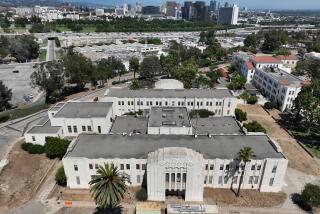Navy Plans for Downtown S.D. Hit Legal Snag
- Share via
SAN DIEGO — The state attorney general’s office is challenging the Navy’s plans to rebuild its 16-acre downtown base and supply center into a huge complex of hotels and high-rise office buildings, saying it violates state restrictions limiting the land to military purposes.
The state’s stand, outlined in two letters and in recent discussions with the Navy, brings into question the future of the Navy project, which has been valued at $400 million to $500 million.
Navy officials directly involved with the project were unavailable for comment Thursday, but public officials who have spoken with them as well as with the state attorney general’s office say the Navy disagrees vehemently with the state’s conclusion.
The state’s involvement has caught the Navy and other San Diego officials by surprise, because the Navy unveiled its plans four years ago, when it announced it would rely mainly on private financing to rebuild the old, squat and drab facility that runs 8 city blocks on the water’s edge between Broadway and Market Street and Pacific Coast Highway and Harbor Drive.
The funding plan will allow developers to build about 1,500 hotel rooms and a large office tower. In return, the developers will pay about 75% of the cost to build the Navy about 1 million square feet of office space on the site. The Navy wants the office space to consolidate many of its San Diego-area administrative functions into what has become known as the Broadway Complex.
The idea of a joint venture between the military and private developers was so new it took congressional approval in 1987 to pursue the plan.
Navy spokesman Cmdr. Doug Schamp said Thursday that, although he isn’t aware of the state’s stand, the rationale behind the joint venture “was to do the rebuilding without taxpayers’ money. And, to do that, we had to give up land to let commercial development pay for Navy office spaces. After all, we got Congress’ approval to do this.”
But the state attorney general’s office says the Navy was given access to the state tidelands in increments by the city of San Diego and the state from 1919 to 1940, specifically for military uses.
“The grant to the United States limited the types of uses of this property to military purposes,” according to a Sept. 11 letter from the attorney general’s office to Don Nay, the head of the San Diego Unified Port District. “Commercial office use for non-maritime purposes would be inconsistent with the public trust and the grant to the Navy. Rental of the non-maritime offices would be inconsistent with the trust and, as a non-military use, with the grant.”
Jamee Jordan Patterson, the deputy attorney general who wrote both that letter and a more detailed, eight-page letter to the Navy on Oct. 4, said the state Legislature hasn’t freed the property for the development envisioned by the Navy.
“We’re concerned about the (California) public not getting its fair share,” she said in a telephone interview. “What they are doing is using California public finances, assets and resources . . . and that translates into California dollars.”
By terms of the state’s title, the land would revert to the state and the Port District if the Navy no longer uses it for military purposes. Patterson said that the state has no problem with a new office building for the Navy or the proposed Navy maritime museum and that the hotel development might pass muster as a recreational use allowed by the state title, but that private office space that isn’t marine-oriented is an outright violation.
Patterson said she has had several meetings with the Navy and the Port District to discuss the situation and described the Navy’s position as “hard-line.”
The state doesn’t want to wind up in court, she said, and is instead seeking a settlement that provides the state and Port District with some kind of compensation. “We’d love to see the old buildings gone and the streets open” through the project to Harbor Drive, she said. “We hope we can work it out, and if it’s not something as the Navy has proposed, then its equivalent.”
Although several lease-options are under discussion, Patterson said, the easiest solution involves the Legislature’s taking action, either by declaring that the property is no longer needed by the state or by finding that the proposed uses are consistent with those allowed by the state’s title. Those uses, outlined in 1850, include using state tidelands for fishing, navigation and maritime commerce.
Patterson said there is nothing unusual in the state becoming involved four years after the first announcement of the project. She said her office analyzed the proposal at the request of the State Lands Commission.
“We’re always jumping into these things, so that’s not unusual,” she said.
One of the attorney general’s concerns is whether the Port District will receive “adequate payment” for giving up land if the foot of Broadway is closed to form a public plaza, as the city has proposed, Patterson said.
Councilman Ron Roberts, who first criticized the Navy’s project as being too massive and later championed it when the Navy reduced it by almost 40%, said Thursday that “the Navy’s attorneys disagree with (the state) completely.”
“We’re going ahead with the planning as if (the state’s involvement) didn’t happen,” he said. “The most unfortunate thing that could happen is that the Navy would never do anything.”
More to Read
Sign up for Essential California
The most important California stories and recommendations in your inbox every morning.
You may occasionally receive promotional content from the Los Angeles Times.













